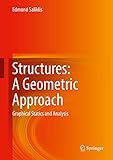Structures: A Geometric Approach [electronic resource] : Graphical Statics and Analysis / by Edmond Saliklis.
By: Saliklis, Edmond [author.] .
.
Contributor(s): SpringerLink (Online service) .
.
Material type:  BookPublisher: Cham : Springer International Publishing : Imprint: Springer, 2019Edition: 1st ed. 2019.Description: XI, 332 p. 701 illus., 699 illus. in color. online resource.Content type: text Media type: computer Carrier type: online resourceISBN: 9783319987460.Subject(s): Civil engineering
BookPublisher: Cham : Springer International Publishing : Imprint: Springer, 2019Edition: 1st ed. 2019.Description: XI, 332 p. 701 illus., 699 illus. in color. online resource.Content type: text Media type: computer Carrier type: online resourceISBN: 9783319987460.Subject(s): Civil engineering1 Introduction -- 2 General Guidelines for Creating Efficient and Elegant Programs -- 3 Non-concurrent Forces and the Funicular -- 4 The Funicular and the Bending Moment -- 5 Truss Analysis and Design -- 6 Frames -- 7 Stability of a Point in 3D Space -- 8 Deflections of Beams and Indeterminate Beam Analysis -- 9 Williot Mohr and Indeterminate Truss Analysis -- 10 Forces in Space.
Graphic methods for structural design essentially translate problems of algebra into geometric representations, allowing solutions to be reached using geometric construction (ie: drawing pictures) instead of tedious and error-prone arithmetic. This was the common method before the invention of calculators and computers, but had been largely abandoned in the last half century in favor of numerical techniques. However, in recent years the convenience and ease of graphic statics has made a comeback in architecture and engineering. Several professors have begun using graphic statics in the classroom.and.studio environment. But until now, there had been no guidebook that rapidly brings students up to speed on the fundamentals of how to create graphical solutions to statics problems. Graphic Statics introduces all of the traditional graphic statics techniques in a parametric drawing format, using the free program GeoGebra. Then, advanced topics such as indeterminate beams and three dimensional curved surfaces are be covered. Along the way, links to wider design ideas are introduced in a succinct summary of the steps needed to create elegant solutions to many static equilibrium problems. Meant for students in civil and architectural engineering, architecture,and construction, this practical introduction will also be useful to professionals looking to add the power of graphic statics to their work.


There are no comments for this item.